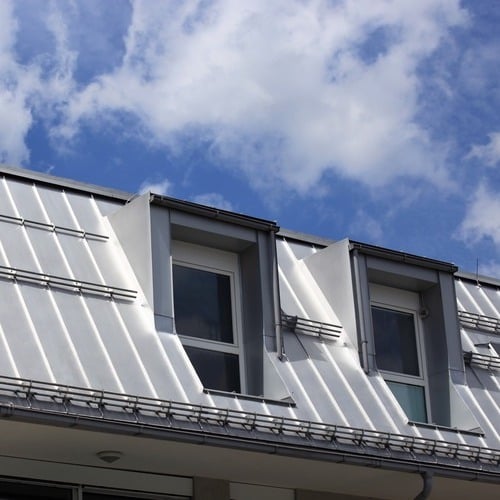- Open 24/7
- 13611 E 104th Ave Henderson, CO
Golden way Roofing

A standing seam metal roof installation is famous for homeowners looking to replace their roofs. This roof’s durability and attractive appearance make it a valuable investment for any home. Whether you need a roof replacement or a new installation, understanding the process and benefits of standing seam metal roofs is crucial.
To begin with, let’s discuss the materials required for a standing seam metal roof installation. These include roof decking, underlayment, lock strip, drip edge, metal panels, clips, Z bar, and ridge cap. The installation involves tearing off the old roofing materials, installing the lock strips and drip edge, putting down the underlayment, installing the metal panels, adding the Z bar flashing, and placing the ridge cap.
It is important to note that standing seam metal roofs differ from screw-down panel roofs commonly used for barns and sheds. Standing seam roofs provide a sleek, modern design that enhances a home’s curb appeal. They also offer durability, energy efficiency, and long-term cost savings.
Standing seam metal roof installation offers numerous benefits for homeowners. The first and foremost advantage is durability. Metal roofs are known for their exceptional longevity and can withstand weather conditions such as heavy rain, strong winds, and hail. Unlike traditional roofing materials that may deteriorate over time, metal roofs are low maintenance and resistant to rot, insect infestations, and fire.
Another significant benefit of standing seam metal roofs is their ability to enhance a home’s curb appeal. With their sleek and modern design, these roofs can transform the look of any property. Homeowners can choose from various colors and finishes, allowing them to customize their roof’s appearance and increase its aesthetic appeal.
Energy efficiency is yet another advantage of standing seam metal roofs. These roofs are designed to reflect solar heat, reducing the heat the building absorbs. As a result, homeowners can enjoy lower energy bills as they rely less on air conditioning to keep their homes cool. Over time, the long-term cost savings from reduced energy usage can offset the initial investment in a standing seam metal roof.
Key benefits of standing seam metal roof installation:
Exceptional durability and resistance to various weather conditions
Enhanced curb appeal with sleek and modern design options
Energy efficiency through solar heat reflection, leading to long-term cost savings
When it comes to standing seam roof installation, choosing a suitable metal is crucial for long-lasting durability and cost-effectiveness. Homeowners have several options, including steel, aluminum, and copper.
Steel: Steel is a popular choice for commercial buildings due to its strength and ability to withstand extreme weather conditions. It offers excellent durability and is cost-effective for homeowners looking for a sturdy and reliable roof.
Aluminum: Aluminum panels are corrosion-resistant and much lighter in weight compared to steel. This makes them easier to install and less prone to damage from excessive weight. While aluminum may be slightly more expensive than steel, its durability and low maintenance requirements make it a worthwhile investment.
Copper: For homeowners looking for a unique and luxurious aesthetic, copper panels are an excellent choice. Copper roofs offer unmatched beauty and develop a distinct patina over time, giving the home a timeless appeal. However, it’s important to note that copper is typically more expensive than steel or aluminum.
Standing seam metal roof installation replaces a roof with a durable and attractive option that uses metal panels with raised seams.
Standing seam metal roofs connect the metal panels using raised seams, providing a sleek and modern design. Other metal roofs, like screw-down panel roofs, use screws to attach the panels and are commonly used for barns and sheds.
Hiring a professional roofing contractor ensures quality workmanship and proper installation. They have the necessary tools and experience to complete the installation correctly and efficiently.
Standing seam metal roofs are durable, low maintenance, resistant to rot and insects, and fireproof. They also enhance a home’s curb appeal and can reflect solar heat, reducing energy bills.
Steel, aluminum, and copper are the most common metals used for standing seam roofs. Steel panels are more robust, aluminum panels are corrosion-resistant, and copper panels offer a luxurious look.
The choice of metal depends on location, budget, and desired aesthetic. Consider each metal option’s durability, cost, and maintenance requirements before deciding.
Following proper installation procedures is essential, as is hiring a professional roofing contractor and using high-quality materials. Regular maintenance, such as inspecting for damage and cleaning debris, is also necessary to preserve the roof’s integrity.
A typical metal standing seam roof build-up includes a weatherproofing layer, thermal insulation, a vapor barrier, and metal panels locked together at the seams.
The difference lies in the design and installation. Standing seam roofs have concealed fasteners and vertical or trapezoidal legs, while corrugated metal roofs display a wavy pattern with exposed screws.
Disadvantages include higher initial cost, complexity of installation, and potential for noise during heavy rain or hail without proper insulation.
Types of metal include aluminum, steel (galvanized and Galvalume), copper, and zinc, each offering different aesthetics and longevity.
Advantages include durability, energy efficiency, and a sleek appearance. Disadvantages focus on cost and the need for specialized installation.
Standing seam metal roofs have hidden fasteners and raised seams, while screw-down panels have exposed fasteners, making them less watertight over time.
Consider climate, aesthetics, budget, and longevity. Aluminum and galvanized steel are popular for their cost-effectiveness and durability.
Metal roofs are more expensive initially, costing about $8 to $14 per square foot compared to asphalt roofs at $3 to $7, but offer longer lifespan and energy savings.
Installation involves securing underlayment, aligning and attaching panels at the seams with clips, and ensuring proper fastening and sealing at edges and penetrations.
Golden way Roofing
© 2024 All rights Reserved. Golden Way Roofing | Powered by Casey’s SEO